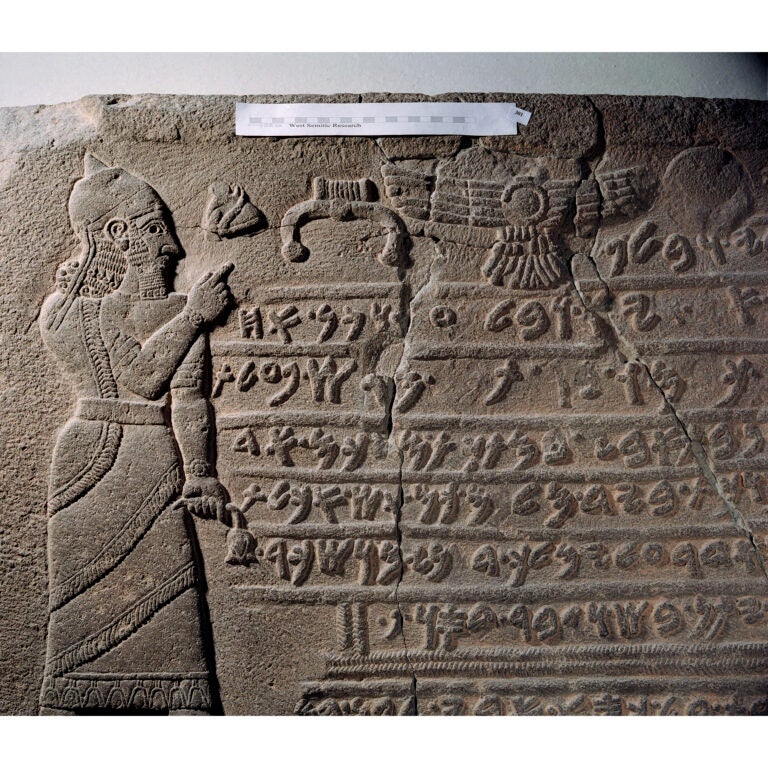Introduction
Around the time Heinrich Schlieman made his legendary discoveries at Troy another German archaeological team was breaking ground in Ottoman Anatolia (modern-day Turkey). At Zinjirli, a site further east near the border of what is now Syria they unearthed the remains of the capital city of the Aramean kings of Yaudy, known in Assyrian sources as Sam’al. A line of eleven Aramean kings ruled this formerly Luwian city state from the early 900s to 713 B.C.E. Monumental inscriptions of four of these kings have survived beginning with the fifth king of the dynasty, Kilamuwa.
Description
Kilamuwa’s inscription was discovered in 1902 at the entrance to his royal palace. It depicts a regal, long robed figure, presumably king Kilamuwa himself. He holds in his hand a wilting lotus, the symbol of deceased kings. With his other hand, he points to several symbols of deities. Beneath these is carved in bas relief the well-preserved sixteen line Phoenician inscription.
Though the language and alphabet are Phoenician, the bas relief style of the letters imitates the style of Luwian hieroglyphics. Kilamuwa’s claim to the throne seems to rest on heredity but he mainly emphasizes the superiority of his achievements compared with his four predecessors. First, there was Gabbar, the founder of Aramean kingship at Yaudy/Sam’al, followed by Bamah. Then came Kilamuwa’s father Hayya and his own brother, or perhaps half-brother, Shail. We know little of the first four kings apart from what Kilamuwa says of them. To showcase his own achievements he says of each of his predecessors, including his father and brother, only that they “accomplished nothing.”
Fortunately, Kilamuwa mentions the names of each of his predecessor’s gods. The names of these kings and their gods all seem to be Semitic. Yet they ruled over a territory largely comprised of an older Luwian population. The Luwians were related to the Hittites. Most scholars believe this group is referred to in the inscription as the mshkbm. Kilamuwa, whose name is Anatolian, mentions the name of his mother, also apparently non-Semitic.

Kilamuwa then describes his own achievements by which he outshone his forbears. He fended off powerful predatory kings on all sides. Only the king of the Danunians to the west proved too much for him. Therefore Kilamuwa “hired” the king of Assyria against this enemy. There is no mention of Kilamuwa by name in the Assyrian records, but Shalmaneser does claim to have gathered the kings of the Hittites together with him in his push toward the coast. This shrewd move resulted in economic prosperity for himself and his subjects, particularly for the mshkbm.
Kilamuwa places special emphasis on his beneficence on behalf of these people, whom the former kings treated like “dogs.” He enriched them with livestock, gold, and textiles such as they had never seen. Furthermore, Kilamuwa seems to have achieved some sort of leveling status for the Luwians vis-a-vis the ruling Arameans.
The inscription describes a curse that will result from defacing his inscription is to be the undoing of this reciprocal honour. “Now if any of my sons who shall sit in my place does harm to this inscription, may the mshkbm not honor the b’rrm, nor the b’rrm honour the mshkbm (Gibson 3.13 lines 13-15, p. 35).” Kilamuwa’s only reference to the gods occurs in the last two lines. Continuing the curses on inscription vandals, he calls upon the gods of each of his predecessors and upon Rakkab El, lord of the dynasty, to smash the head of anyone who smashes the inscription.

We cannot be certain of the exact nature of the social equilibrium Kilamuwa was trying to accomplish. If the hybrid Anatolian/Aramean influences apparent for the next century in the art, architecture, and language of Sam’al are any indication, then he must have succeeded. After Kilamuwa there followed six more kings of Sam’al before this Aramean kingdom practically vanishes from history. Fortunately, two of his successors also left monumental inscriptions. Unlike the Kilamuwa inscription, these are not in Phoenican. There are either in the hybrid Phoenician/Aramaic dialect called Sam’alian or, with the last inscriptions of Sam’al, in Mesopotamian Aramaic.
Source: Rainey, Anson. Sacred Bridge.
Photograph. by Bruce and Kenneth Zuckerman and Marilyn Lundberg, West Semitic Research. © Staatliche Museen zu Berlin—Vorderasiatisches Museum.

Article Categories
Non-Biblical Ancient Texts Relating to the Biblical World: Non-biblical inscriptions and documents from ancient times that improve our understanding of the world of the Bible.
Biblical Manuscripts: Images and commentary on ancient and medieval copies of the Bible.
Dead Sea Scrolls: Images and commentary on selected Dead Sea Scrolls manuscripts.
USC Archaeology Research Center: Images of artifacts from the teaching collection of the University of Southern California.